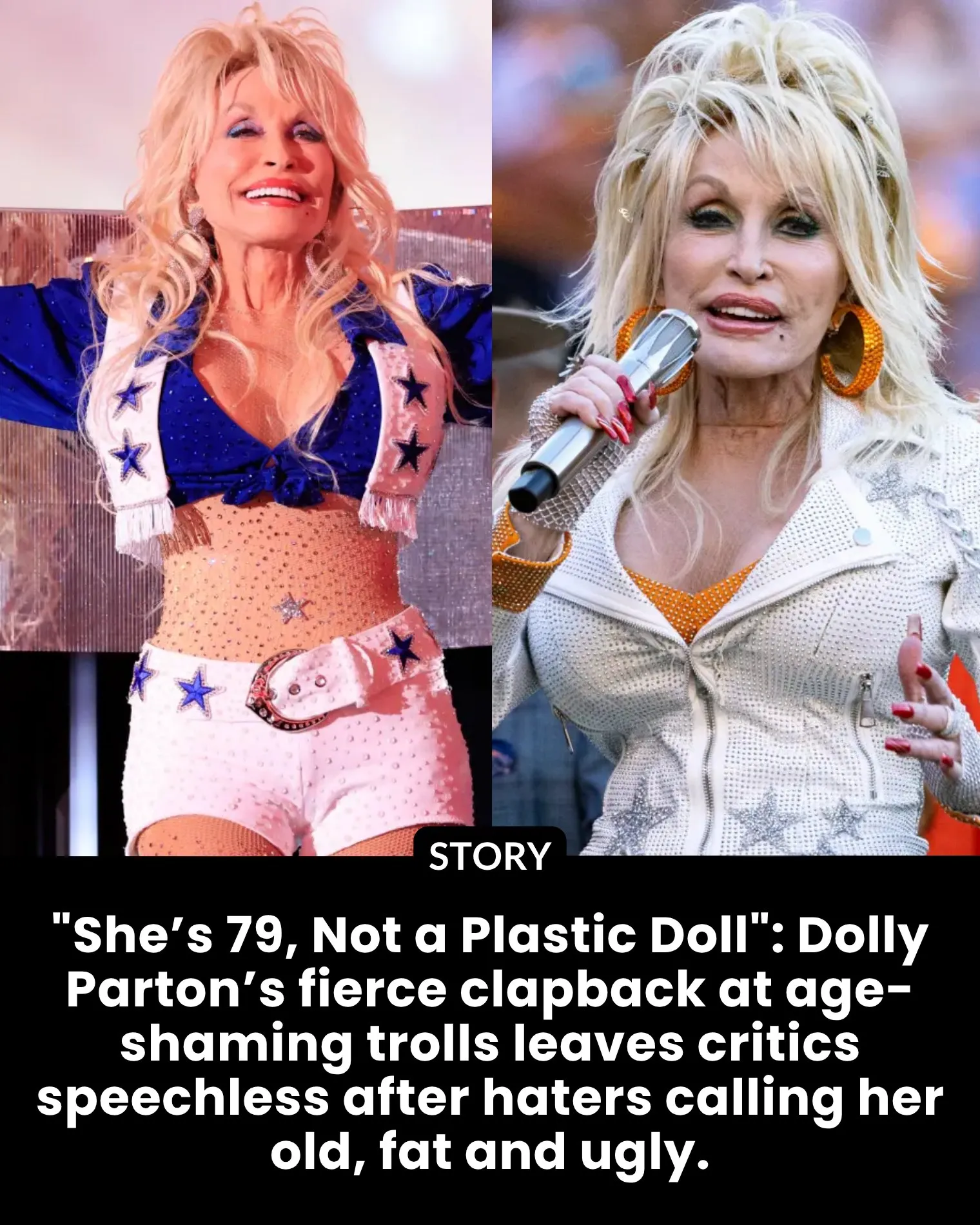Nashville, USA — November 2025
A LEGEND UNDER ATTACK
At 79, Dolly Parton has lived long enough, loved hard enough, and worked tirelessly enough to earn every ounce of respect she receives. Yet even the most beloved American icon is not immune to the cruelty of online trolls. In recent months, Parton has found herself the target of vicious age-shaming attacks from critics who mock her for being “old, fat, and ugly,” attacking everything from her flamboyant fashion to her unapologetically glamorous style.
But Dolly Parton, a woman who has survived poverty, Hollywood sexism, tabloid battles, and decades of scrutiny, is not someone who breaks easily. Her response—sharp, funny, and rooted in a lifelong personal philosophy—has left critics speechless. She didn’t just clap back; she reframed the entire conversation around beauty, aging, and self-worth.
Her answer was simple and brilliant:
“I was not a natural beauty—I CREATED my beauty.”
It wasn’t a defense. It was a declaration.
OWNING HER IMAGE — A BRAND WORTH $100 MILLION
Parton has never hidden the fact that she built her appearance intentionally—hair, makeup, heels, and all. For her, beauty has always been an art, a costume, a form of creative expression. Long before the internet existed, Dolly turned her image into a brand worth more than $100 million in record sales alone, plus a global entertainment empire stretching from Dollywood to books, films, and philanthropy.
Her flamboyant look—big hair, big personality, big heart—was never about hiding flaws. It was about creating a character so magnetic that audiences couldn’t look away. She has said many times that she modeled her look after the “town tramp” she admired as a child, not because she wanted to be provocative but because she admired the confidence such a woman radiated.
“I never wanted to look natural,” she has joked. “I wanted to look like Dolly.”
This is why the insults don’t land. Calling Dolly Parton “fake” is like accusing Mickey Mouse of having big ears. It’s the point. It’s the art. It’s the brand.

BEAUTY, AGE, AND FEMININITY — ON DOLLY’S TERMS
Trolls often weaponize age to undermine women who refuse to fade into the background. For Dolly, aging has never been something to fear or deny. She acknowledges it with humor and clarity. She’s undergone cosmetic procedures, yes, but she’s never pretended otherwise. She dresses boldly not because she wants to look young, but because the style suits her spirit.
“I’m a show pony,” she often says. “I don’t play the subtle card.”
By embracing artifice, Dolly calls out the hypocrisy of a society that demands women be effortlessly beautiful while simultaneously shaming them for trying. She frees herself—and millions of fans—from the impossible expectation of natural perfection.
When trolls mocked her for looking “too old to dress that way,” Dolly clapped back with a line that instantly went viral:
“If I’m 79, and what I do bothers you, don’t look. I’m not a plastic doll—I’m a very expensive one.”
It was witty, but also deeply true: Dolly has agency. Dolly has power. Dolly has earned the right to express herself however she pleases.
THE POWER IN REINVENTION
Dolly’s philosophy is more than glamour; it’s survival. Coming from a poor family in rural Tennessee, she learned early that confidence wasn’t given—it had to be constructed. She used makeup as armor, fashion as identity, and performance as liberation.
Every rhinestone on her dresses symbolizes a choice: to shine instead of shrink.
Her look also became a feminist statement long before the word “feminism” entered mainstream music. Dolly defied expectations of modesty, humility, and aging placed on women in country music—a genre historically hostile to female ambition. Her unapologetic style forced the industry to confront its biases.
In this sense, Dolly’s clapback to trolls is more than personal. It’s political.
She exposes how society polices female bodies, particularly older women’s bodies, with punitive cruelty. Her message is clear:
Beauty belongs to the woman who wears it—not to the people who judge it.

A CAREER BUILT ON AUTHENTICITY
Ironically, the woman most accused of being “fake” is one of the most authentic figures in American culture. Dolly’s transparency about her surgeries, her wigs, her makeup, and her insecurities has made her a role model for generations. She’s openly joked,
“It costs a lot of money to look this cheap.”
But behind the humor is wisdom. Dolly’s entire ethos rests on the idea that self-creation is a legitimate form of personal empowerment.
She has never claimed to be naturally beautiful. She claims ownership of the beauty she invented—and that is far more radical than pretending to be effortlessly flawless.
THE CLAPBACK THAT SILENCED EVERYONE
When confronted with the nastiest insults—calling her “old,” “ugly,” or “fat”—Dolly didn’t lash out. She didn’t insult anyone back. She simply asserted the truth:
“I don’t do this to be young. I don’t do it to be sexy. I do it because this is me. I’m 79 years old, and I’ll look how I want.”
The elegance of her response is its refusal to engage with hatred. Instead, she elevates the conversation: about agency, creativity, womanhood, and aging on your own terms.
A LEGEND BEYOND BEAUTY
Dolly Parton’s legacy will never be defined by trolls. It will be defined by the songs she wrote, the literacy programs she funded, the millions she has given to children, hospitals, and scientific research. It will be defined by the joy she brings—not by the opinions of anonymous strangers online.
And so, when haters try to tear her down, she simply reminds them:
She’s 79. She looks like Dolly Parton. And that’s more than enough.
